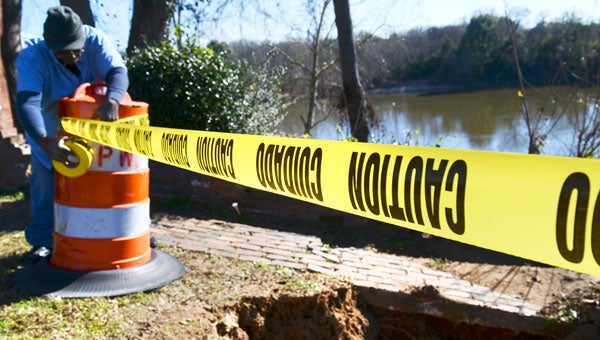Collapsed storm drain thought to be cause of park sinkhole
Published 6:24 pm Wednesday, December 18, 2013

Selma Public Works employee Marvin Green ties a section of caution tape around a sinkhole Wednesday in Bienville Park. (Jay Sowers | Times-Journal)
The process to repair a sinkhole that opened up over the weekend in Selma’s Bienville Park began Wednesday with the arrival of three orange barrels and a line of caution tape.
Ray Hogg, owner of Hogg Engineering and an engineering consultant for the city of Selma, said he thinks the age of an underground storm drain line could eventually be found to be the cause for the sinkhole.
“From what I can tell, there is a corrugated metal pipe that comes down Lauderdale Street and it extends under the monument and out to the river,” Hogg said.“I suspect the top or a part of the pipe has corroded. It happens with older corrugated metal pipes, and it’s probably been there many years. When it rains, a little bit of the dirt around the pipe would wash away and that eventually creates the sinkholes.”
Tommy Smith, director of Selma’s Public Works Department, was on site to oversee the temporary installation of the barrels and tape around the hole, and said sinkholes like this become commonplace as a city’s underground infrastructure.
“This is an old city with old infrastructure,” Smith said. “They start as a drip and then this happens. We’ve had storm drain cave-in’s like this happen in the past.”
Smith said his next step would be to meet with Selma Mayor George Evans, who would then contact Hogg to begin looking into the cost of possible repairs.
Hogg said Wednesday his initial thought would be the entire storm drain could need to be replaced if the corrosion is severe enough.
“The best way to fix it is to replace it,” Hogg said. “It’s not the only way, but it’s the best way but it does cost the most. It may be that they could dig down on it and they could put a wrap-around on it, but I don’t know that it is possible without seeing it.”
Smith said a lack of maps detailing the lengths and ages of existing storm drain lines makes the prospect of predicting sinkholes even more difficult.
“That’s another question, I don’t know how far it services up the road,” Smith said. “We don’t have maps of these old lines. Do we know we have a problem? Yes. Do we know when these problems are going to pop up? No. There is always a concern when you have an old infrastructure that it might collapse, and when it occurs we try to address it.”





